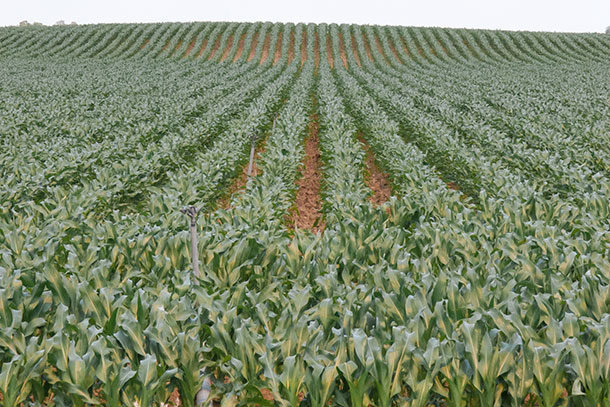The corn balance sheet is primarily driven by total supply (this year’s production plus beginning stocks), feed demand, demand from the ethanol industry and exports. Let’s compare the upcoming 2000-21 marketing year balance sheet to the 2019-20 marketing year balance sheet using June projections. Total supply is projected to increase 14.1%, due to an increase in planted acreage and the expected return to trend yield. Feed demand is projected to increase 6.1% and is expected to reach its highest level since 2005. Ethanol demand is projected to increase 6.1%.
Though higher than the 2019-20 demand levels, the 2000-21 demand for corn from the ethanol industry is substantially lower than the levels reached in 2017-18 and 2018-19. Corn used for exports is expected to increase from 1.77 billion bushels in 2019-20 to 2.15 billion bushels in 2000-21. Putting all the pieces together, the increase in total supply swamps the increase in demand, causing the stocks-to-use ratio to increase from 15.3% in 2019-20 to 22.5% in 2000-21. As a result, the U.S. marketing year average price is expected to decline from $3.60 in 2019-20 to $3.20 in 2000-21.
As noted above, feed demand is a very important component of domestic corn demand. With this in mind, we will examine cattle-finishing feeding cost of gain and dried distillers grain (DDG) prices.
Cost of gain
In addition to corn prices, cattle-finishing feeding cost of gain is sensitive to changes in feed conversions and alfalfa prices. Using data for the last 10 years, regression analysis was used to examine the relationship between feeding cost of gain and feed conversion, corn prices, and alfalfa prices. Results are as follows: each 10 cent increase in feed conversion increases feeding cost of gain by $1.24 per hundredweight (cwt), each 10 cent per bushel increase in corn prices increases feeding cost of gain by 88 cents per cwt, and each $5 per ton increase in alfalfa prices increases feeding cost of gain by 50 cents per cwt. Using this information, the 50 cent drop in corn prices from late January to early June reduced feeding cost of gain per cwt by $4.40 and will likely result in the lowest feeding cost of gain in the second half of this year since early 2017.
Dried distillers grains
DDGs are an important feed ingredient for most animal species. Given the substitutability of DDG for corn and soybean meal prices, we would expect DDG prices to be significantly related to these feedstuffs. Regression analysis using data from January 2007 to December 2019 for central Illinois was used to help explain the relationship between DDG prices and corn and soybean meal prices. Results are as follows: each 10 cents per bushel ($3.57 per ton) increase in corn prices results in a $2.33 per ton increase in DDG prices, and each $10 per ton increase in soybean meal prices results in a $2.18 per ton increase in DDG prices. Given this information, the 50 cent drop in corn prices from late January to mid-June would result in a $11.65 per ton drop in DDG prices. However, it is important to note that DDG prices were relatively high in April and May due to relatively low ethanol production during these two months. As ethanol plants increase production in response to increased fuel demand coming out of the sheltering-in-place COVID-19 restrictions, we would expect DDG prices to move downward in response to the lower corn prices.
Forecasts
What about long-run trends in corn prices? The Food and Agricultural Policy Research Institute (FAPRI) at the University of Missouri recently released updated forecasts of corn prices for the 2000-21 through the 2025-26 marketing years. Their estimate for 2000-21 is $3.06, which is below the current World Agricultural Supply and Demand Estimates (WASDE) estimate of $3.20. For the 2021-22 through 2025-26 marketing years, FAPRI estimates that U.S. corn price will range from $3.19 in 2021-22 to $3.35 in 2025-26. In other words, their forecasts suggest that corn prices are going to stay below the 2019-20 marketing year average price for the extended future. ![]()
Michael Langemeier is with the Center for Commercial Agriculture at Purdue University.
PHOTO: Staff photo.









